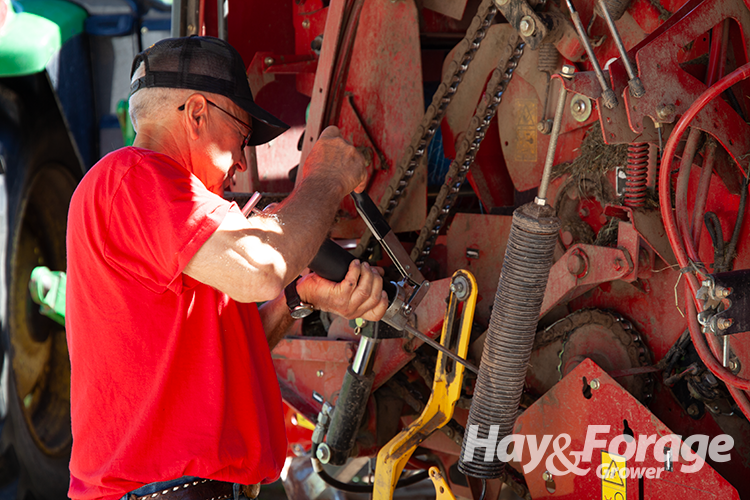
As we look ahead to winter, plan to get your equipment in the shop and give each haymaking tool a good maintenance makeover. Some manufacturers have winter inspection programs for larger equipment, including round balers. I encourage you to take advantage of these inspections. You can do all the work changing parts yourself, but having a trained eye look over your equipment can be priceless come next summer’s hay season.
I want to cover all the items you should look at if you wish to do your own baler inspections this winter. First, be sure you start with a clean baler. Take time to blow off the dirt and chaff and give the outside a wash, if you choose. Just be sure to protect all electrical computers from the water! Once it’s clean, service the unit with the recommended grease and oil and then spray worn areas with diesel.
Have a process
Come up with your own checklist to follow or go online and find a previously constructed one. I always start at the front and work down the left side, around the back, and then back up the right side.
Be sure to check your clevis hitch and drawbar pin. We once had a customer who experienced the top of his drawbar pin breaking while driving down the road. If you can, remove the power takeoff (PTO) shielding to get a good look at the constant velocity (CV) joint and PTO tubing. Sometimes, the tube can bind up and bend slightly, causing a wobble that you can’t see with the cover on. Check the gear oil in the main gearbox.
Next, inspect the pickup assembly for broken teeth and bent stripper bands. Check the pickup drive chain if it’s located on the left side. Moving on to the main drive chain, which is located on the left of most balers, remove it from the sprockets. See if you can find the proper length it’s supposed to be, and if your chain is 2% longer, it’s time to replace it. If the chain makes a crescent shape when bent to the side, that’s another indication it needs replaced.
Be sure to release all the tension on the belts in the chamber. This will make it easier for you to remove chains and to test each roller. With the chains off, you can spin each roller by hand and listen for any grinding and feel for any roughness or movement when prying with a bar. These are all signs of wear or “play” in a bearing and the need to change it before it causes major damage. While the chains are off, check the sprockets. If there is any “hook” to the teeth on a sprocket or excessive wear to the bottom of the tooth, they need replacing. If possible, soak your chains in a lubricant while you have them off the baler.
Moving on to the belts, check their lacing and replace the pins if the baler has them. Inspect the roller scrapers, belt tracking guides, and rollers for flat spots. You can also measure belt length at this time. The net-wrap system causes the most headaches during the season, so make sure you inspect the mechanical features and test the electrical ones as well. Clean the sensors and make sure they do not have any damage to the surface. You can also test the bale shape sensors to make sure they are working properly. This is the best time to check wiring harnesses for any damage or compromised areas.
Relieve the tension
Make sure all your hydraulic cylinders look good and are not leaking. This is especially important on the bale density system because it is a more involved process to recharge. I recommend leaving the tension off your belts while in storage over winter. This ensures you do not have pressure on your rollers and bearings. We also leave the rear door propped open to relieve pressure on the rear door cylinders. I recommend spraying the inside walls and pickup with fluid film, light oil, or diesel fuel to help prevent rust and corrosion during the winter. This will ensure your first bale comes out looking great next spring.
Something that gets overlooked are the wheel bearings and lugs. If you can find the torque specifications, it’s a good practice to recheck the lug torques, especially on newer balers.
Winter is typically the best time to stock up on your parts. It’s also a good time to preorder net wrap and plastic, as this time of year offers the best deals, and you may be able to delay payments.
This article appeared in the November 2025 issue of Hay & Forage Grower on page 30.
Not a subscriber? Click to get the print magazine.
